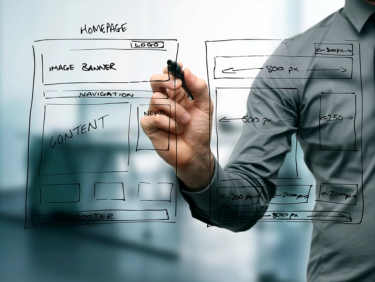Insight9 min read
New website, new design: How we approach redesigning your site for success
Mon Feb 12 2024 | Marketing Team

- Insight
- Web & eCommerce
- Design, UX & UI
Tags
You’ve decided it’s time for a new website, now what?
When you make the move from your current website to a brand-spanking new one, there are countless considerations to make to ensure your project is a success. From which platform suits your business best to what additional functionalities you might want to incorporate, building your new site brings with it a whole host of questions. But the first question that tends to be on everybody’s lips:
‘What about the new design?’
With every agency viewing the design process slightly differently, we thought we’d give you the lowdown on how we approach your new eCommerce site.
So you want a design at pitch stage?
A new website is equal parts exciting and daunting. There are so many factors to consider to get it right and ultimately, you invest a lot of money and time into your new site, so you want it to be perfect off the bat. Ensuring you hit the mark and create a website that delivers can feel overwhelming.
Once you’ve been given the go-ahead to start your project, it can be tempting to focus on your site’s end design and jump right in, asking for a visual at pitch stage. Although some agencies might use this approach, providing you with draft creative from your initial brief, we like to do things a little differently at idhl.
Instead of creating designs based on assumptions during pitches, we want to get to know your brand, dig deep into your pain points, understand your audience and create a design based on real-life data. So, how do we approach creating the perfect design?
Well, it goes a little something like this…
How research and discovery help your design take shape
A project is only as good as the research that underpins it. We start your project with a thorough research and discovery phase, questioning your assumptions and really bedding down into any issues you currently have.
Throughout our research, we have one core goal in mind: understanding your business needs and how we can create a website to support this. Starting with an internal kick-off meeting, we bring our team together to discuss the project specifications and to learn more about your goals from your dedicated account manager. Once we’re all aligned, it’s time for our team to meet yours, begin the external project kick-off and start the discovery phase…
While every project differs to best suit the client’s brief, here are some of the things you can expect:
Project run-through: We understand it can be daunting when you’re building a new site or re-platforming and being kept in the loop is vital to the long-term success of our partnership. From our first meeting, we explain to you the project lifecycle and what you can expect during your journey with us.
Sailboat exercise: To create a website that really packs a punch we need to understand ‘what puts the wind in your sails.’ While the question might sound a little cheesy, we use this exercise to dig deeper into what is moving you forward/working well and what is anchoring you/ stopping your progress. This helps to build the initial framework for your web project.
Stakeholder interviews: Talking to the key members of your team, we get to grips with any pain points your key stakeholders have with the site and delve into what they want from the project.
User interviews: Your new site has one role that takes priority above all else – serving your user. By speaking directly to your audience, or working with a curated pool of target users, we can better understand what is most important to your users; from what is working well, to priority areas of improvement.
UX workshops: Ultimately, your website needs to serve your users, so they can serve your business. Taking the time to understand how they experience your site is imperative at this stage of your project. During this process we might look at persona definitions, M3 exercises and remote usability.
Competitor reviews: Understanding what your competitors are doing, and doing well, is an important consideration when redesigning your site.
Design and research: A match made in heaven
The design of your site should be factored into every stage of your project but is particularly important to consider throughout the research phase. Every aspect of research is relevant to our designers, who use this information to shape the final design of your website. From challenges and pain points, to what’s working and what your core goals are, having our designers in the loop throughout the research phase helps to create the perfect end product.
As your project grows, key decisions for your site stem from this initial research phase. Content modelling and site structure briefs all come from the information gathered through workshops, audits and competitor analysis, informing design decisions.
Designers are key to your website’s success, so why wouldn’t you want them to be part of your project from the start? With important design decisions based on the findings from research, having designers there to see, understand and take note of them is imperative. Instead of relaying this information at a later stage, designers can hear firsthand the frustrations, challenges and positives with your current site and how this needs to translate into the design concepts.
Giving our design team access to users and stakeholders also means they can bed down into the issues at hand and pose questions that may influence your new website. To put it simply, if they aren’t involved, it’s much harder to accurately tell you what your users need and what you’re missing.
If at first you don’t succeed, test and test again
We work collaboratively, bringing together the strengths of our UX and design teams to test our designs continuously throughout your project, using tools such as tree testing and card sorting. The findings from these tests allow us to validate our research and design choices, helping you to understand why we’ve chosen to redesign your site in this way. Once testing is complete, and any changes actioned, we move on to content modelling and then into concept design.
As we move forward, we continue to test our designs – ensuring that every step of the way we’re backing our decisions with real-life feedback. Using pools of target users or your users, we run a number of UX tests and tweak designs based on this data. Every site is different, so we don’t advise a set formula for testing, but here’s a snippet of what we can do:
- User interviews
- First click testing
- User testing
- Click and scrolling heatmaps
- Preference tests
- User surveys
Once testing is complete, designs signed off, and everyone is happy, we can move forward to development.
You can’t have a new design without some development
Design in place, it’s time to begin creating your new website. At this stage, our design team don’t simply hand off a design brief and call it a day. Ensuring everyone is on the same page, our designers work closely with our development team during the initial stages of development.
What’s more, the dev team will already have been involved with your project before it lands on their desk to start building. Designers and developers communicate throughout the design curation process, ensuring that the designs we put together are feasible, tick all your boxes and are within your budget.
This close collaboration means when it’s time to commit to your new design, there are no surprises or last-minute changes needed to fit your brief. With the build underway, our design team hand the reins over to our developers and the rest, as they say, is history.
Are you thinking about redesigning your site?
Experts in all things eCommerce, we know what it takes to help our clients create a website that really packs a punch. Our processes mean that when your new site launches, you know that it will deliver what you set out to achieve.
Throughout your project, our team collaborates not only with you but seamlessly with our internal teams. And by involving our designers from the word go, you can be sure that your new design ticks all the boxes, not just for you, but for your all-important customers, too.
Want to learn more about our design process and how this will positively impact your next website?
Get in touch.


